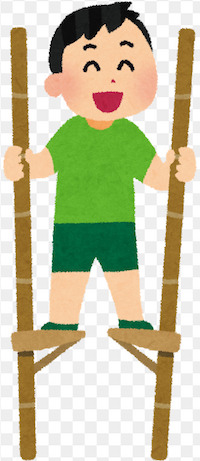When I was a kid growing up in Maysville, anytime the weather was decent, we were outside. We weren’t poor, but I didn’t have a lot of “store-bought” toys — nobody did. So my friends and I made a lot of our “toys,” or various things to play with and/or occupy our time. In the past I’ve mentioned some of the things we made and talked about making things with and for our kids, even though when they were young, there were a lot more “story-bought” toys available.
Today, July 17, is one of those special days that often goes unnoticed — it’s National Walk on stilts Day. Stilts are one of the things we usually made every summer, and of course, the older we got the higher we made the stilts.
I hadn’t thought about stilts for a long time and it’s not a subject that gets much notice today. I suppose kids still walk on stilts, but I don’t remember seeing a kid on stilts in a long, long time. When stilts come to mind, you usually think of a circus — just about every circus has some guy walking on really high stilts.
I usually think of stilts in terms of “entertainment,” but they are used in many industries, especially the construction industry. Stilts are even used in sheepherding — in France, shepherds used them to watch their flocks from an elevated position. In construction, there is often a need to work at a height above the ground higher than a worker can reach, and where constantly moving a ladder is a pain. A good example of this is the drywall industry — in fact if you check Amazon, you can buy drywall stilts.
So anyhow, when I noticed it was Stilts Day, I thought it might be a good time to talk about something else that was popular in my childhood that’s just about disappeared today….
On the seacoast of southern France, there is a soggy region called Les Landes. As the seasons change, the earth changes from salt marsh to damp plains, most of it isn’t either land or water. For centuries, the people their found their own strange way to live with those conditions — they relied on stilts. Propped up on stilts, shepherds tended their flocks, mail carriers made their rounds, stumping on their stilts. Stiltwalking housewives, chatted in the market in their black clothes, and were said to resemble large ravens perched on dead branches. The children did their chores, went to school, and played sports — all on stilts. The people of this region became the most skillful stiltwalkers in the world.
Workers in the fruit orchards of California have a saying, “One pair of stilts is worth a dozen ladders.” Stilts are commonly used to prune and harvest the trees in a handy and efficient manner.
I mentioned stilts in the circus — one famous circus performer lives in London near Piccadilly Circus, which isn’t a circus, but a busy circular area in the heart of the city. Harry Yelding claims to hold the world’s record for waling on the tables stilts — as a clown, he performs on stilts that measure twenty-two feet from his ankles t the ground. He sometimes strolls through the London streets, window-shopping in third-story windows.
Even though Yelding gets a lot of publicity, his stilts are not the highest — in 2008, Roy Maloy of Australia took 5 steps on stilts 46 ft. high, claiming the unofficial world record.
Archaeological ruins and texts show that stilt-walking was practiced in ancient Greece as far back as the 6th century BC.

The stilts that I made as a kid, were hand-held stilts — they weren’t tied or strapped to my legs, I just stood on a “step” attached to a pole. But there are other type of stilts….
Peg stilts, also known as Chinese stilts, are often used by professional performers. These stilts strap on at the foot, ankle, and just below the knee. The stilt walker needs to keep moving to keep their balance.
I mentioned earlier drywall stilts — these are designed to allow the stilt walker to walk or stand still.
Spring stilts are spring-loaded stilts that allow the user to run, jump and perform various acrobatics.
Digitigrade stilts are peg stilts whose line follows the foot and not the shin bone — this allows costumers to mimic some animals.
Articulated stilts are similar to drywall stilts in that they allow the stilt walker to stand in one place without shifting their weight from foot to foot. This are commonly used in theme parks.
So stilts provided me entertainment as a kid, but it was something kids do — as we get older we have to realize that…
Someone said that it is in vain that we get upon stilts, for once on them, it is still with our legs that we must walk. And on the highest throne in the world, we are still sitting on our own ass.
— 30 —
